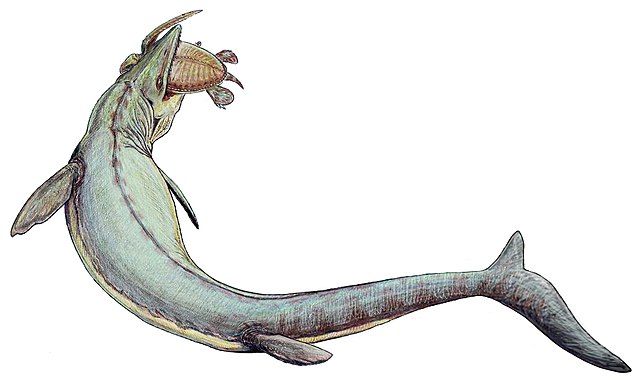Secondarily aquatic tetrapods
From Wikipedia, the free encyclopedia
Several groups of tetrapods have undergone secondary aquatic adaptation, an evolutionary transition from being purely terrestrial to living at least part of the time in water. These animals are called "secondarily aquatic" because although their ancestors lived on land for hundreds of millions of years, they all originally descended from aquatic animals (see Evolution of tetrapods). These ancestral tetrapods had never left the water, and were thus primarily aquatic, like modern fishes. Secondary aquatic adaptations tend to develop in early speciation as the animal ventures into water in order to find available food. As successive generations spend more time in the water, natural selection causes the acquisition of more adaptations. Animals of later generations may spend most their life in the water, coming ashore for mating. Finally, fully adapted animals may take to mating and birthing in water or ice.
This article needs additional citations for verification. (July 2007) |
Marine reptiles
Summarize
Perspective
Mesosaurs

Mesosaurs were a group of small aquatic reptiles that lived during the early Permian period (Cisuralian), roughly 299 to 270 million years ago. Mesosaurs were the first known aquatic reptiles, having returned to an aquatic lifestyle from more terrestrial ancestors.[1] Most authors consider mesosaurs to have been fully aquatic, although adult animals may have been only semiaquatic.[2]
Turtles
Archelon is a type of giant sea turtle dating from the Cretaceous Period, now long extinct. Its smaller cousins survive as the sea turtles of today.
Squamates

Squamata is the largest order of reptiles, comprising lizards, snakes, and amphisbaenians (worm lizards). There are many examples of aquatic squamates, both living and extinct; a secondarily aquatic lifestyle has evolved multiple times.
Living at the same time as, but not closely related to, dinosaurs, the mosasaurs resembled crocodiles but were more strongly adapted to marine life. Scientists continue to debate on whether monitor lizards[3] or snakes [4] are the closest living relatives of mosasaurs. Mosasaurs became extinct 66 million years ago, at the same time as the dinosaurs.

Modern squamates which have made their own adaptions to allow them to spend significant time in the ocean include marine iguanas and sea snakes. Sea snakes are extensively adapted to the marine environment, giving birth to live offspring and are largely incapable of terrestrial activity. The arc of their adaptation is evident by observing the primitive Laticauda genus, which must return to land to lay eggs.
Ichthyosaurs
These marine reptiles had ancestors who moved back into the oceans. Ichthyosaurs adapted as fully as the dolphins they superficially resemble, even giving birth to live offspring instead of laying eggs.
Crocodilomorphs
Crocodilomorphs are a group of reptiles that include crocodilians and their extinct relatives. Many though not all crocodilomorphs had an aquatic or semiaquatic lifestyle. One group, the Metriorhynchidae displayed extreme adaptions for life in the open ocean, including the transformation of limbs into flippers, the development of a tail fluke, smooth, scaleless skin,[5] and probably even live birth.[6]

Sauropterygians
Sauropterygians developed from terrestrial ancestors soon after the end-Permian extinction and flourished during the Triassic before all except for the Plesiosauria became extinct at the end of that period. The plesiosaurs went extinct at the Cretaceous–Paleogene extinction event, the same event which killed the non-avian dinosaurs. Sauropterygians include placodonts, nothosaurs, plesiosaurs, and pliosaurs.
Marine mammals
Summarize
Perspective
Cetacea
During the Paleocene Epoch (about 66 - 55 million years ago), the ancient whale Pakicetus began pursuing an amphibious lifestyle in rivers or shallow seas. It was the ancestor of modern whales, dolphins, and porpoises. The cetacea are extensively adapted to marine life and cannot survive on land at all. Their adaptation can be seen in many unique physiognomic characteristics such as the dorsal blowhole, baleen teeth, and the cranial 'melon' organ used for aquatic echolocation. The closest extant terrestrial relative to the whale is the hippopotamus, which spends much of its time in the water and whose name literally means "horse of the river".
Sirenians
The ancestors of the dugong and manatees first appeared in the fossil record about 45 to 50 million years ago in the ocean.
Pinnipeds
The fossil records show that phocids existed 12 to 15 million years ago, and odobenids about 14 million years ago. Their common ancestor must have existed even earlier than that.
Polar bears
Although polar bears spend most of their time on the ice rather than in the water, polar bears show the beginnings of aquatic adaptation to swimming (high levels of body fat and nostrils that are able to close), diving, and thermoregulation. Distinctly polar bear fossils can be dated to about 100,000 years ago. The polar bear has thick fur and layers of fat on its body to protect it from the cold.
Speculative theories
Humans
Proponents of the aquatic ape hypothesis believe that part of human evolution includes some aquatic adaptation, which has been said to explain human hairlessness, bipedalism, increased subcutaneous fat, descended larynx, vernix caseosa, a hooded nose and various other physiological and anatomical changes. The idea is not accepted by most scholars who study human evolution.[7]
See also
Related topics
- Fin and flipper locomotion
- Tradeoffs for locomotion in air and water
- Evolution of cetaceans
- Vertebrate land invasion
Lists
References
Wikiwand - on
Seamless Wikipedia browsing. On steroids.